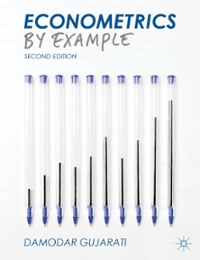Question
based from the textbook Charles Jones, Macroeconomics International Student Edition,5th edition Part 1 For this question assume that inflation is zero. Consider a 2-period economy.
based from the textbook Charles Jones, Macroeconomics International Student Edition,5th edition
Part 1
For this question assume that inflation is zero.
Consider a 2-period economy.
Assume that consumer's lifetime utility is given by
= log 1 + 0.8 log 2 (1)
Assume that the consumer starts period 1 with the initial wealth of 50,000.
The consumer gets labour income in period t (t=1,2).
1 = 20,000, 2 = 120,000, 1 = 5,000, 2 = 31,500 and R=0.05 (2)
Initially assume that there are no borrowing constraints.
a. Write down the Euler equation (with all values substituted) and explain its meaning. Write the intertemporal budget constraint and explain its meaning.
b. Solve consumer's problem of maximizing lifetime utility subject to the intertemporal budget constraint. Is the present value of consumption in the first and the second periods the same? Explain why.
c. If for some reason the consumer were facing the borrowing constraint, would it be binding? Explain.
d. Answer a.-c. for the case when =0.95 instead of 0.8 and R=0.5 instead of 0.05. (note that you don't have to repeat the explanation of the Euler equation and the intertemporal budget constraint.)
Part 2
Now suppose that there are two types of consumers in the economy: type 1 and type 2. Both types have the same life-time utility (1), the same labour income, taxes and the interest rate (outlined in (2)) but the first type has initial financial wealth of 50,000 and the second type does not. Assume that the banks require collateral for the loans and given that the second type does not have any initial financial wealth, this consumer faces borrowing constraints.
a. Is the constraint facing type 2 consumer binding? How much would the type 2 consumer consume in the first and second periods?
Suppose that the total population size is equal to 1. Suppose further that a fraction of the total population is type 1 consumers and a fraction (1- ) is type 2 consumers.
b. Derive the economy's aggregate consumption function for period 1, that is, derive an expression for total consumption 1 = 11 + (1 )12
c. Assume that the government plans spending of 10,000 in period 1 and 15,750 in period 2. The initial debt is 10,000. The taxes collected from consumers are 5,000 in period 1 and 31,500 in period 2. Is the government budget constrain satisfied? Explain.
d. Assume that in the economy described in this part, the government decides to build some new roads in period one which requires an increase in spending from 10,000 to 15,000. The government decides whether to use tax finance or debt finance for this extra spending in period 1. If you are an economic expert and are asked for advice, what would you recommend and why?
Part 3
Comment on the following statement "If the real interest rate falls from 5% (0.05) to 1% ( 0.01), the government will be able to decrease current taxes without the need to increase taxes in the future"
Step by Step Solution
There are 3 Steps involved in it
Step: 1

Get Instant Access to Expert-Tailored Solutions
See step-by-step solutions with expert insights and AI powered tools for academic success
Step: 2

Step: 3

Ace Your Homework with AI
Get the answers you need in no time with our AI-driven, step-by-step assistance
Get Started


